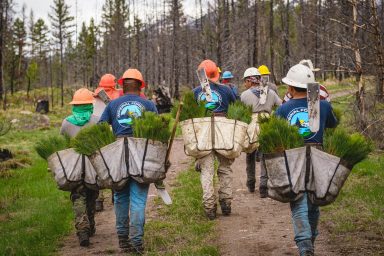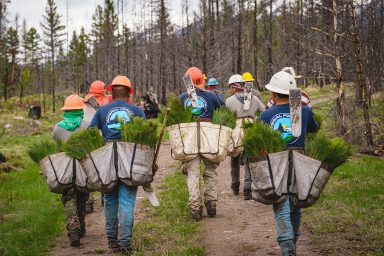Climate tech startup Living Carbon is developing genetically engineered poplar trees that it says can absorb more carbon. Some say the company is rushing to commercialize its “supertrees.”
|
Listen To This Story
|
- US climate technology startup Living Carbon has been developing genetically engineered poplar trees that it says can absorb more carbon — a potential tool in the climate crisis.
- Some experts say the company lacks long-term field data and is rushing to commercialize its “supertrees,” potentially putting other species at risk.
- Despite such concerns, Living Carbon is going ahead and planting mixed forests that include its GE trees, funded by carbon offsets.
Trees are a major tool in our fight against climate change by sucking up carbon dioxide, but one company is taking them a step further: genetically engineering trees to sequester even more carbon. US climate technology startup Living Carbon is developing genetically engineered seedlings of a hybrid poplar that it says can accumulate up to 53 percent more biomass than control plants and thereby absorb 27 percent more carbon.
Plants use sunlight to turn water and carbon dioxide into oxygen and sugar, a process known as photosynthesis. Living Carbon says its trees, a hybrid of the common aspen (Populus tremula) and white poplar (P. alba), can do it better with genetic changes to boost its photosynthetic performance.
This solution emphasizes the potential role of synthetic biology in climate adaptation and carbon removal, and while the tweaking of trees’ genome has many proponents, not everyone is convinced. Critics warn these GE trees could lead to environmental damage and spread outside of plantation areas.

The US government has approved the commercial planting of Living Carbon’s GE trees. Image courtesy of Living Carbon. Photo credit: Courtesy of Living Carbon / Mongabay
Sucking Carbon, Slowing Decay
Founded in 2019, Living Carbon has started strong. After collecting $15 million in seed funding and receiving a $500,000 grant from the US government in 2021, the San Francisco-based group raised $21 million, pledging to capture 604 million metric tons (666 million US tons) of CO2 — or 1.7 percent of 2021 global annual emissions — from 2023 to 2030.
Humans have long used selective breeding to improve specific traits of plants, including edible crops, said Maddie Hall, who left US research group OpenAI to create Living Carbon with paleobiologist Patrick Mellor.
“We are not modifying trees for herbicide resistance or to introduce specific narrow traits that are conducive to monocultures of our trees alone,” she said. “Instead, we are introducing general traits that enhance growth rate — with slowed decomposition next in the pipeline, which are beneficial to any tree.”
Besides carbon capture, Living Carbon is boosting trees’ ability to accumulate metals like nickel or copper from toxic soils to better resist fungal decay. The group, which said it had seen a 97 percent survival rate of its seedlings on its abandoned mine planting projects, plans to have more than 4 million seedlings in the ground by early 2024.
“We believe that biotechnology can have integrative and restorative effects on ecosystems when practiced with intentions other than maximizing crop yield within a monoculture,” Hall said.
But experts are questioning the ability of these “supertrees” to live up to their promises without damaging surrounding ecosystems.

Living Carbon says its GE trees can absorb up to 27 percent more carbon than control plants. Photo credit: David Vig / Unsplash
‘Over-the-Top Hype’?
In September, organizations with the Campaign to STOP GE Trees said in a report that the only scientific study discussing Living Carbon’s research was the company’s own white paper, which was not initially peer-reviewed. The critics also said the company had failed to show that its GE trees could continue to grow at an increased rate throughout their lifetime.
“We initially published our white paper on [biology preprints server] bioRxiv because we wanted to make the research available to everyone at the time the company launched publicly,” Hall said. “The paper has since been peer-reviewed and published in a special edition of Forests.”
Anne Petermann, the campaign coordinator and director of the Global Justice Ecology Project (GJEP), says she continues to have strong reservations about the project.
“Besides my concerns about their nonchalant attitude about changing the evolutionary trajectory of trees, I have found their hype to be a bit over-the-top,” she wrote to Mongabay, adding that even one of Living Carbon’s key partners was “uncomfortable.”
Citing molecular geneticist Ricarda Steinbrecher, Petermann said genetic engineering could create numerous unexpected effects, including mutations and alterations in the genome of GE trees “that happen not just at the moment of transformation, but over time, and not just to the organism itself, but potentially to progeny.”
But Hall said Living Carbon’s poplars would be unable to produce pollen — since all the GE trees are female.
However, even if that did occur, she said, “the risks would be limited to a localized increase in accumulation of biomass,” because the other tree species planted by the company aren’t closely related enough to fertilize the GE trees.
Petermann noted that poplars, especially, can reproduce vegetatively and resprout from the stump as well: “They will eventually cross national or tribal boundaries.”
Highlighting a growing flow of information about “the critical importance of fungal pathways in forest soils in facilitating communication between and among trees, not to mention in storing carbon in forest soils and providing nutrients to other trees,” she said Living Carbon’s “supertrees” could have an evolutionary advantage over non-GE poplars — such as the ability to reach sunlight faster.
“Rot-resistant trees disrupt the natural cycle in ways that are not understood at all,” Petermann said.
“This is especially problematic in an organism like a tree that lives or can live for such a long time and interacts with so many other organisms,” she added, emphasizing the need for field trials that last decades and cover several generations of trees.

Scientists highlight the need for longer-term field data to assess all the genetic engineering risks. Photo credit: Courtesy of Living Carbon via Mongabay
USDA’s Green Light Raises Red Flag
Living Carbon has begun commercial pilot planting to assess the performance of its seedlings “in scenarios more akin to real-world planting,” Hall said. Living Carbon isn’t planting a monoculture, but mixed forests, with a total of 12 species included in its carbon project plantings so far. To date, it has planted around 8,900 photosynthesis-enhanced hybrid poplar trees among mixed plantings in the states of Georgia and Ohio. GE trees make up for about 5 percent of their plantings.
But this debunks the company’s claims, according to Petermann: “How can they possibly claim to be able to confidently store and measure [carbon] if their ‘53 percent faster growing trees’ are only one part of a matrix of trees?”
The U.S. Department of Agriculture (USDA) recently concluded that these “supertrees” did not need to be regulated as genetically modified organisms (GMOs) and could be commercially planted.
Yet, for Petermann, the agency gave Living Carbon’s trees a pass under “extremely arcane” rules developed in the 1980s to address whether a GMO plant may be a “plant pest risk.” Living Carbon uses a different technology that the USDA hasn’t evaluated, she said: the “gene gun” method, which fires microscopic “bullets” coated with genetic material into the cells.
“The result is the same: new genes are introduced into the DNA with all of the associated damage to the genome … and all of the unpredictable impacts that it will cause,” Petermann said. “It is not that the USDA thought these trees were safe; they just said that they were outside of their mandate.”
By contrast, a similar genetic-engineering effort, to impart blight resistance to the American chestnut tree (Castanea dentata), a species decimated by a pest fungus, has been awaiting approval for release since 2020.

In Suzano, Brazil, experts say the planting of GE eucalyptus trees could be more ecologically destructive than non-modified plantations already are. The banner reads “Eucalyptus plantations are not forests.” Image courtesy of Orin Langelle. Photo credit: Courtesy of Orin Langelle via Mongabay
Selling Carbon Credits, or Treading Warily
To fund its projects, Living Carbon sells carbon credits to entities eager to offset emissions valued on the carbon that its trees will potentially suck up.
According to the Boston Consulting Group (BCG), the voluntary carbon market could be worth up to $40 billion by 2030, up from $2 billion in 2021. But carbon offsets have recently sparked concerns around their lack of transparency, potential adverse impacts on local communities, or the fact that they may give polluters a license to emit.
“We have forward agreements for carbon credits that will be delivered in 2024 and 2025,” Hall said. “This is standard practice in carbon removal and renewables and necessary to obtain project financing.”
She added the majority of sales were directly negotiated with corporate buyers, while some were made through platforms like Watershed or Patch.
“We are in the process of submitting some of our projects for verification with the American Carbon Registry [ACR], and exploring next-generation methodologies such as [nonprofit organization] BCarbon that may be a better fit for future projects,” Hall said.
For Petermann, the “carbon credits, which they first said were verified by Verra … raise more flags.” A recent investigation into the world’s leading carbon standard found that more than 90 percent of Verra’s rainforest offset credits were likely worthless.
“This makes Living Carbon’s sales pitch doubly troubling,” Petermann added. “There is no upside that I can see.”

As weather events intensify, some say “supertrees” may be part of the climate solution. Photo credit: John Towner / Unsplash
Urgent Solutions for Urgent Times
Robin Chazdon, a professor of tropical forest ecology at the University of the Sunshine Coast in Australia, said GE tree planting for carbon sequestration may appeal to futuristic investors, but is “very risky and prone to failure.”
She said GE trees are more susceptible to diseases and herbivores. Moreover, their lack of genetic diversity may weaken them in the face of environmental challenges like climate change.
In addition, Chazdon said that “trees engineered to grow quickly have low wood density and short life spans in general, so the overall amount of carbon stored is low, particularly if they are harvested after a few years.”
“In the end, you will not get a forest out of it either, so the potential for multiple benefits — biodiversity, income generation for local people, use of trees for food or firewood — will not be possible,” she added. “There are many [other] effective solutions that can be adopted along with decarbonizing energy sources.”
Bill Laurance, a research professor at James Cook University in Australia, said the world tends to get “overly freaked out” about GE organisms.
“Playing God is risky, but humans have actually been doing it for thousands of years,” he wrote in an email to Mongabay, while adding that “ecological engineering” approaches can be prohibitively expensive and only have modest benefits.
But, he said, “As a group, trees capture and store more carbon than any other type of organism, so I think it’s reasonable to focus on trees as a potential means to reduce atmospheric carbon levels.”
“They’re not a one-size-fits-all tool, but trees are definitely going to be part of any viable climate solution,” Laurance said.
This story by Juliette Portala was originally published by Mongabay and is part of Covering Climate Now, a global journalism collaboration strengthening coverage of the climate story.




